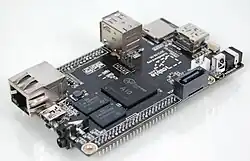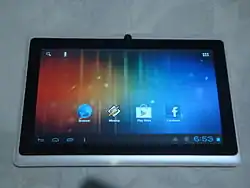Allwinner A1X
The Allwinner A1X is a family of single-core SoC devices designed by Allwinner Technology from Zhuhai, China. Currently the family consists of the A10,[1] A13,[2] A10s[3] and A12. The SoCs incorporate the ARM Cortex-A8 as their main processor[4] and the Mali 400 as the GPU.

The Allwinner A1X is known for its ability to boot Linux distributions such as Debian, Ubuntu, Fedora, and other ARM architecture-capable distributions from an SD card, in addition to the Android OS usually installed on the flash memory of the device.
A1x Features

Video acceleration
- HD video decoding (up to 3840x2160)
- Supports popular video codecs, including VP8, AVS, H.264 MVC, VC-1, and MPEG-1/2/4[1]
- HD Video Encoding (H.264 High Profile)
- Multi-channel HD displays
- Built-in HDMI
- YPbPr, CVBS, VGA
- LCD interfaces: CPU, RGB, LVDS up to full 1080p HDTV
Memory
- DDR2/DDR3 SDRAM, 32-bit
- SLC/MLC/TLC/DDR NAND
Connectivity
- USB 2.0
- CSI, TS
- SD Card 3.0
- 10/100 Ethernet controller
- CAN bus (A10 only)[5] [6]
- Built-in SATA 2.0 Interface
- I²S, SPDIF and AC97 audio interfaces
- PS2, SPI, TWI and UART
Storage and boot devices
Implementations
Many manufacturers have adopted the Allwinner A1X for use in devices running the Android operating system and the Linux operating System. The Allwinner A1X is used in tablet computers, set-top boxes, PC-on-a-stick, mini-PCs, and single-board computers.
- PengPod,[7] Linux-based 7 and 10-inch tablets.
- Gooseberry, a board based on the A10 SoC similar to the Raspberry Pi.
- Cubieboard, a board based the A10 SoC.
- Tinkerforge RED Brick, a board based on the A10s SoC [8]
- CHIP (computer), a $9 SoC computer based on the A13
Operating System support
Linux support
The Allwinner A1X architecture is referred to as 'sunxi' in the Linux kernel source tree. The source code is available at GitHub.[9] At the moment, stable and full hardware support is limited to 3.0.x and 3.4.x kernels. Recent mainline versions of the kernel run, but do not offer NAND access and have only limited 3D-acceleration.[10]
FreeBSD support
There is a work in progress on support Efika on FreeBSD. At the moment, not all on-board peripherals are working.[11]
OpenBSD support
As of May 2015, OpenBSD's armv7 port supports the Cubieboard and pcDuino boards based on the Allwinner A1X.[12]
Documentation
No factory sourced programmers manual is publicly available for the A10S CPU at this moment.
Allwinner A-Series
Apart from the single-core A1x (A10/A13/A10s/A12), two new more powerful Cortex-A7 Allwinner SoCs have been released by Allwinner, the A10-pin-compatible dual-core Allwinner A20, and the quad-core Allwinner A31.[14]
References
- "A10_Allwinner Technology". Archived from the original on 2015-11-22. Retrieved 2015-11-21.
- "A13_". Archived from the original on 2014-05-02. Retrieved 2014-04-30.
- "A10s_". Archived from the original on 2014-04-29. Retrieved 2014-04-30.
- Ltd, Arm. "News – Arm®". Arm | The Architecture for the Digital World. Retrieved 15 April 2023.
- "Datasheet" (PDF). Archived from the original (PDF) on 2013-07-17. Retrieved 2012-09-27.
- "Data sheet" (PDF). Archived from the original (PDF) on 2013-07-17. Retrieved 2012-09-27.
- "PengPod Wiki". Archived from the original on 2014-02-17.
- "Blog | Tinkerforge".
- "linux-sunxi". GitHub. Retrieved 2014-06-30.
- "Linux mainlining effort - linux-sunxi.org". linux-sunxi.org. Retrieved 15 April 2023.
- Ganbold (26 December 2012). "Allwinner A10". freebsd-arm (Mailing list). Retrieved 24 June 2014.
- "OpenBSD/armv7". OpenBSD. Retrieved 2015-05-30.
- "NetBSD/evbarm on Allwinner Technology SoCs". NetBSD. Retrieved 2015-05-30.
- "Allwinner throws A20 dual-core and A31-quad-core processors into ARM fray".